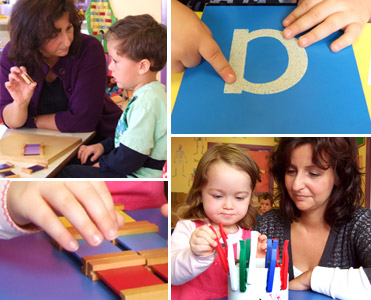

Wake Forest Montessori School.
1.“ Follow the Child”
One of the most beautiful components of Dr. Maria Montessori’s philosophy is that teachers “follow the child” to her own potential. This means that teachers present individual lessons to children based on her own intellectual capabilities. Respect is given to the child to work at her own pace. Subsequently, children may excel beyond grade level and surpass state standards.
2.Freedom of Choice in Work
Because the children may choose their own work based on the lessons that they have been presented, the children are engaged, enthused, and purposeful in their work. The children develop a sense of ownership in their work, their lessons, and become active participants in their education.
3. Freedom of Movement
In the Montessori classroom, the child is free to move with purpose to acquire materials needed to perform a lesson or activity. Movement in the classroom requires that the child develop self-discipline and self-control. The child becomes independent and confident in the environment. Because the child is allowed to take care of himself or herself, the child feels respected and safe in the classroom.
4. Educational Manipulative Materials
Montessori created beautifully inviting materials as an integral part of her lessons. The materials are not only aesthetically sensorially pleasing, but serve as important concrete models of concepts presented in the lessons. Montessori also believed in isolating the difficulty for the child, therefore, a multitude of materials may be used in sequence to facilitate the child’s progression from the concrete to abstract thinking.
5. Multi-Age Classrooms
Observing that children learn best in environments likened to family and home, Montessori designed her classrooms to include children of three sequential ages. Her extensive studies of children and how they learn led her to divide children into four planes of development and sensitive periods of learning. The children are grouped together in multi-age classrooms to meet the needs of the child. In the Montessori classroom, the younger children feel encouraged and capable of achieving mastery of work when they see older students completing the lesson. These groupings benefit older students as well because older children will feel capable, confident, and competent serving as mentors and role models to the younger children. Ideally, the children spend three years in the same Montessori classroom with the same teacher who nurtures and educates the child with a continuum of development.
6. Cosmic Curriculum
Maria Montessori developed the cosmic curriculum to excite and enthuse the child to his or her inner most core. The child is presented lessons on subjects from the entirety of the universe to discover how wonderful and wonder-filled the universe actually is.
7. Practical Life
Montessori believed that children should be empowered to become independent, stating, “The essence of independence is learning to take of oneself.” Practical life activities, such as scooping, pouring, sweeping, sewing, gardening, and conflict resolution, encourage independence, responsibility, confidence, and competence. The children feel valuable, capable, and empowered.
8. Earth Conscious Curriculum
Believing in the importance of honoring, respecting, and understanding the inter-connectedness of all living things, Montessori developed her botany and zoology curriculum to inspire children to care for the Earth and all of her living creatures. Lessons also include introducing and practicing the concept of “reduce, reuse, and recycle,” in turn, reducing our carbon footprint.
9. A Global Village
With multi-cultural curriculum and classrooms, children learn to be respectful of all human beings from all corners of our Earth. Students learn the names of each continent’s countries, capitals, flags, and landforms, as well as examining customs and cultures of people throughout our globe. Montessori believed that children who know about the Earth and its inhabitants would be the peacekeepers of our world. The Montessori method is perhaps even more relevant is today’s global village.
10. Peace Curriculum
Maria Montessori was committed to creating peace in our world through the education of our children, stating “Creating peace is the work of education. All politics can do is keep us out of war.” She believed that children were “both the hope and promise for the future of mankind” and developed lessons for children to learn how to solve their own problems peacefully. Maria Montessori was nominated for the Nobel Peace Price in 1951 and 1952.
By Rachel Wallace Reid, Certified Montessori Teacher and Parent Educator

